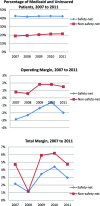Facing the recession: how did safety-net hospitals fare financially compared with their peers?
- PMID: 25220012
- PMCID: PMC4254123
- DOI: 10.1111/1475-6773.12230
Facing the recession: how did safety-net hospitals fare financially compared with their peers?
Abstract
Objective: To examine the effect of the recession on the financial performance of safety-net versus non-safety-net hospitals.
Data sources/study setting: Agency for Healthcare Research and Quality Hospital Cost and Utilization Project State Inpatient Databases, Medicare Cost Reports, American Hospital Association Annual Survey, InterStudy, and Area Health Resource File.
Study design: Retrospective, longitudinal panel of hospitals, 2007-2011. Safety-net hospitals were identified using percentage of patients who were Medicaid or uninsured. Generalized estimating equations were used to estimate average effects of the recession on hospital operating and total margins, revenues and expenses in each year, 2008-2011, comparing safety-net with non-safety-net hospitals.
Data collection/extraction methods: 1,453 urban, nonfederal, general acute hospitals in 32 states with complete data.
Principal findings: Safety-net hospitals, as identified in 2007, had lower operating and total margins. The gap in operating margin between safety-net and non-safety-net hospitals was sustained throughout the recession; however, total margin was more negatively affected for non-safety-net hospitals in 2008. Higher percentages of Medicaid and uninsured patients were associated with lower revenue in private hospitals in all years, and lower revenue and expenses in public hospitals in 2011.
Conclusions: Safety-net hospitals may not be disproportionately vulnerable to macro-economic fluctuations, but their significantly lower margins leave less financial cushion to weather sustained financial pressure.
Keywords: Hospital safety-net; financial performance; recession.
© Health Research and Educational Trust.
Figures
Similar articles
-
Comparing the Affordable Care Act's Financial Impact on Safety-Net Hospitals in States That Expanded Medicaid and Those That Did Not.Issue Brief (Commonw Fund). 2017 Nov 1;2017:1-10. Issue Brief (Commonw Fund). 2017. PMID: 29232088
-
Hospital financial performance in the recent recession and implications for institutions that remain financially weak.Health Aff (Millwood). 2014 May;33(5):739-45. doi: 10.1377/hlthaff.2013.0988. Health Aff (Millwood). 2014. PMID: 24799569
-
Predictors of Payer Mix and Financial Performance Among Safety Net Hospitals Prior to the Affordable Care Act.Int J Health Serv. 2016;46(1):166-84. doi: 10.1177/0020731415586408. Epub 2015 May 19. Int J Health Serv. 2016. PMID: 25995304
-
Texas hospitals with higher health information technology expenditures have higher revenue: A longitudinal data analysis using a generalized estimating equation model.BMC Health Serv Res. 2016 Apr 5;16:117. doi: 10.1186/s12913-016-1367-9. BMC Health Serv Res. 2016. PMID: 27048305 Free PMC article. Review.
-
Characteristics of Safety-Net Hospitals, 2014.2016 Oct. In: Healthcare Cost and Utilization Project (HCUP) Statistical Briefs [Internet]. Rockville (MD): Agency for Healthcare Research and Quality (US); 2006 Feb–. Statistical Brief #213. 2016 Oct. In: Healthcare Cost and Utilization Project (HCUP) Statistical Briefs [Internet]. Rockville (MD): Agency for Healthcare Research and Quality (US); 2006 Feb–. Statistical Brief #213. PMID: 27929631 Free Books & Documents. Review.
Cited by
-
The Health and Social Needs of Patients Discharged From the Emergency Department With Suspected COVID-19.Public Health Rep. 2021 May;136(3):309-314. doi: 10.1177/0033354920982579. Epub 2021 Feb 16. Public Health Rep. 2021. PMID: 33593138 Free PMC article.
-
Analysis of Hospital Operating Margins and Provision of Safety Net Services.JAMA Netw Open. 2023 Apr 3;6(4):e238785. doi: 10.1001/jamanetworkopen.2023.8785. JAMA Netw Open. 2023. PMID: 37071422 Free PMC article.
-
Defining safety net hospitals in the health services research literature: a systematic review and critical appraisal.BMC Health Serv Res. 2021 Mar 25;21(1):278. doi: 10.1186/s12913-021-06292-9. BMC Health Serv Res. 2021. PMID: 33766014 Free PMC article.
-
Adapting to a Shifting Health Care Landscape: Illinois Breast and Cervical Cancer Program Lead Agencies' Perspectives.Health Promot Pract. 2019 Jul;20(4):600-607. doi: 10.1177/1524839918776012. Epub 2018 May 14. Health Promot Pract. 2019. PMID: 29759013 Free PMC article.
-
Cost inefficiency under financial strain: a stochastic frontier analysis of hospitals in Washington State through the Great Recession.Health Care Manag Sci. 2017 Jun;20(2):232-245. doi: 10.1007/s10729-015-9349-8. Epub 2015 Dec 17. Health Care Manag Sci. 2017. PMID: 26677847
References
-
- AHA Data Viewer. 2014. [accessed on March 25, 2014]. Available at http://www.ahadataviewer.com/glossary/
-
- Bachrach D, Braslow L, Karl A. Toward a High Performance Health Care System for Vulnerable Populations: Funding for Safety-Net Hospitals. The Commonwealth Fund. 2012 and. “.” [accessed on August 15, 2014]. Available at http://www.commonwealthfund.org/publications/fund-reports/2012/mar/vulne....
-
- Bazzoli GJ, Clement JP. The Experiences of Massachusetts Hospitals as Statewide Health Insurance Reform was Implemented. Journal of Health Care for the Poor and Underserved. 2014;25(1):63–78. - PubMed
-
- Bazzoli GJ, Fareed N, Waters TM. Hospital Financial Performance in the Recent Recession and Implications for Institutions That Remain Financially Weak. Health Affairs. 2014;33(5):739–45. - PubMed
-
- Bazzoli GJ, Kang R, Hasnain-Wynia R, Lindrooth RC. An Update on Safety-Net Hospitals: Coping with the Late 1990s and Early 2000s. Health Affairs (Millwood) 2005;24(4):1047–56. - PubMed
Publication types
MeSH terms
LinkOut - more resources
Full Text Sources
Other Literature Sources
Miscellaneous


